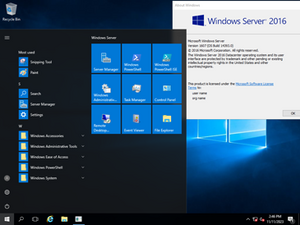| Version of the Windows NT operating system | |
 Screenshot of Windows Server 2016 with Desktop Experience | |
| Developer | Microsoft |
|---|---|
| Written in |
|
| OS family | Windows Server |
| Working state | Current |
| Source model | |
| Released to manufacturing | September 26, 2016[1] |
| General availability | October 12, 2016[2] |
| Latest release | 1607 (10.0.14393.7515) (November 12, 2024[3]) [±] |
| Marketing target | Business |
| Update method | Windows Update, Windows Server Update Services, SCCM |
| Platforms | x86-64 |
| Kernel type | Hybrid (Windows NT kernel) |
| Default user interface | Windows shell (Graphical) Windows PowerShell (Command line) |
| License | Trialware, Volume licensing, Microsoft Software Assurance, MSDN subscription, Microsoft Imagine |
| Preceded by | Windows Server 2012 R2 (2013) |
| Succeeded by | Windows Server 2019 (2018) / Windows Server, version 1709 (2017) |
| Official website | Windows Server 2016 (archived at Wayback Machine) |
| Support status | |
| |
| Part of a series of articles on |
| Windows 10 |
|---|
| Siblings |
| Related |
Windows Server 2016 is the eleventh release of the Windows Server operating system developed by Microsoft as part of the Windows NT family of operating systems. It was developed alongside Windows 10 and is the successor to the Windows 8.1-based Windows Server 2012 R2. The first early preview version (Technical Preview) became available on October 1, 2014 together with the first technical preview of System Center.[5] Windows Server 2016 was released on September 26, 2016 at Microsoft's Ignite conference[1] and reached general availability on October 12, 2016.[2]
It was succeeded by Windows Server 2019 and the Windows Server Semi-Annual Channel, which was released in 2017. Mainstream support for Windows Server 2016 ended on January 11, 2022, and extended support will end on January 12, 2027.
- ^ a b Chapple, Erin (September 26, 2016). "Announcing the launch of Windows Server 2016". Hybrid Cloud. Microsoft. Archived from the original on August 21, 2017. Retrieved September 27, 2016.
- ^ a b Foley, Mary Jo (October 12, 2016). "Microsoft's Windows Server 2016 hits general availability". ZDNet. CBS Interactive. Archived from the original on October 15, 2016. Retrieved October 12, 2016.
- ^ "November 12, 2024—KB5046612 (OS Build 14393.7515)". Microsoft Support. Microsoft.
- ^ "Microsoft Product Lifecycle". Microsoft Support. Microsoft. Archived from the original on October 2, 2019. Retrieved December 7, 2016.
- ^ "Announcing availability of Windows Server Technical Preview and System Center Technical Preview". Hybrid Cloud. Microsoft. March 17, 2015. Archived from the original on August 2, 2017. Retrieved April 1, 2015.